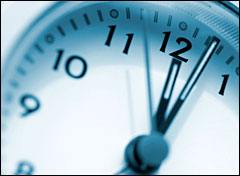
Daylight savings goes into effect this weekend, and with it comes the semiannual arguments over whether the program actually saves time and energy. Those of us who can change our clocks correctly can spend our extra hour parsing new claims that extending daylight savings saves energy and money.
What’s that? We lose an hour? Then here’s a short roundup of the research, to make up for lost time:
U.S. Reps. Ed Markey (D-Mass.) and Fred Upton (R-Mich.) issued a statement yesterday declaring that they’ve been “vindicated” for their 2005 legislation that extended daylight savings by four weeks. From their release:
The Markey-Upton Daylight Saving Time (DST) program saved American families nearly $500 million and 2.9 million barrels of oil during the extension of the program in 2007, according to a government report.
“This is one of the few times in life when we can actually prove the old adage that time is money,” said Markey. “Government analysis has proven that extra sunshine provides more than just smiles. Daylight Saving Time not only saves consumers money, but also curbs the nation’s energy consumption, while reducing carbon emissions that lead to global warming.”
The Department of Energy report [PDF], released last October, found the Daylight Saving Time Extension led to electricity savings of about 1.3 Tera Watt-hour (TWh), which translates to $498 million in electricity savings.
Markey and Upton bolster the energy claim with some familiar arguments: daylight later in the day reduces traffic accidents and crime and makes Halloween safer for children. “Not to mention the additional hour of sunshine in the evening will help chase away the winter blues,” said Upton.
But it’s the energy claims that have received the most scrutiny. When Indiana adopted statewide daylight saving for the first time in 2006, University of California-Santa Barbara conducted an extensive study (seven million monthly meter readings across southern Indiana), and found the change cost ratepayers an extra $8.6 million in electricity bills. The key factor: the reduced cost of lighting in late afternoons was outweighed by higher air-conditioning costs on hot afternoons and higher heating costs on chilly mornings.
Two other research projects have reached similar it’s-not-worth-it conclusions: an Australian study of a two-month extension of daylight saving for the 2000 Sydney Olympic, and a statistical analysis by the California Energy Commission.
And a revelation sure to inspire congressional inquiries and costly government studies: Chickens in Cocoa, Florida, don’t like laying eggs in the dark, USA Today reports. Even more DST facts available from U.S. News & World Report.


